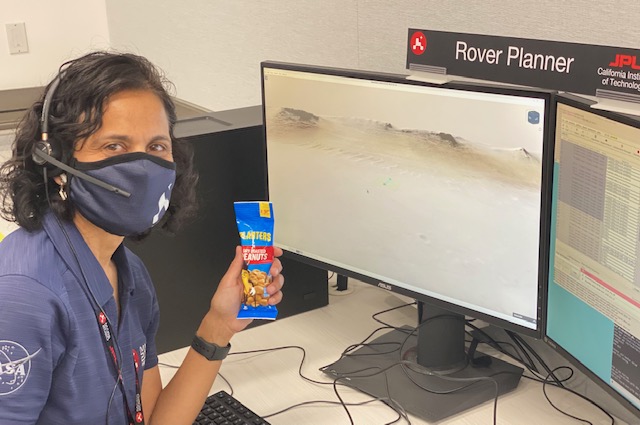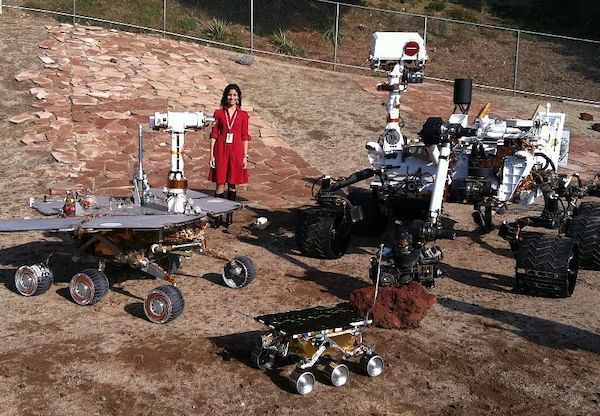Hidden Figure: NASA’s Space Roboticist Vandana ‘Vandi’ Verma Has the ‘Coolest Job in the World’
- As the chief engineer for Robotic Operations for the Mars 2020 Perseverance rover, the Indian American was responsible for driving the Mars rovers using software she co-wrote and developed.

Last week, Dr. Swati Mohan made headlines for calmly narrating the landing events from inside mission control as the Perseverance rover landed on Mars. The aerospace engineer with a bindi, who navigated the descent and landing of the rover in the Martian atmosphere near the Jezero crater, instantly became an internet sensation.
But did you know there was another Indian American woman who played a significant role in the same Mars mission?
Meet space roboticist Dr. Vandana ‘Vandi’ Verma. As the chief engineer for Robotic Operations for the Mars 2020 Perseverance rover, Verma was responsible for driving the Mars rovers using software including PLEXI, that she co-wrote and developed. She is also the Assistant Section Manager for Mobility and Robotics Systems at NASA Jet Propulsion Laboratory in Pasadena, California.
As per her NASA profile, Verma specializes in space robotics, autonomous robots and robotic operations, and is interested in “robotic operations, and robotic software and algorithms that enable autonomy and commanding under uncertainty.” At NASA, she works on the Mars 2020 Sample Caching System algorithms and flight software, and AEGIS flight software for autonomous science targeting.

Since 2008 she has been driving Mars rovers (MER, MSL) and operating the robotic arm and sampling system. She has worked on a number of robotics research projects and has deployed robots in the Arctic, Antarctica and Atacama. She enjoys coding and has written flight software that runs onboard Curiosity and Perseverance, and simulation software used in operations.
Rover Planner
On the NASA website, Verma elaborates on the work she does at its Jet Propulsion Laboratory (JPL). “As Chief Engineer for Robotic operations my role is to provide technical leadership for operating the robotics on Perseverance,” she says. “It’s an engaging job since robotic operations attracts knowledgeable engineers with no dearth of good ideas.” Some of the things she works on are rover driving, including planning autonomous navigation, performing all the activities with the robotic arm and the sample caching system, handling the rover interface to the Ingenuity Mars Helicopter, and performing post-activity data analysis. “I am also in the driver’s seat for these roles as a Rover Planner.”
In her role as assistant section manager for Mobility and Robotics she “helps lead about 150 JPL roboticists developing new technology for future missions and working on a variety of JPL robotic missions,” she says. “The Mars Ingenuity Helicopter technology is an example of the kind of innovation developed by our section.” In her role as flight software developer she designs and programs new capability such as the Rover Collision Modeling capability that will enable the rover to deploy the robotic arm on a target itself.

At JPL, Verma works with a diverse team of scientists and engineers. In a previous interview with WFLA-TV, virtual channel 8, an NBC-affiliated television station licensed to Tampa, Florida, she said: “People are so passionate about space here at JPL. You’re working with people who just love what they do.”
A glance at Verma’s Twitter profile takes you through the last few days until Feb. 18, when NASA made history by successfully landing its Perseverance rover on the surface of Mars. On Feb. 11, a week before the landing, Verma tweeted: “Love the last week before landing as all the Mars rover drivers for the mission get together to test drive and discuss details. @NASAPersevere is a leap in driving, robotic arm, and sampling capability, and we’re deploying a helicopter to boot. Can’t wait!”
Love the last week before landing as all the Mars rover drivers for the mission get together to test drive and discuss details. @NASAPersevere is a leap in driving, robotic arm, and sampling capability, and we're deploying a helicopter to boot. Can't wait! #CountdownToMars
— Vandi Verma (@spaceroboticist) February 12, 2021
A tweet a day prior to D-Day said: “Just finished the Robotic Operations anomaly response tag up. Less than 21 hours to landing. Mars here we come!”
Just finished the Robotic Operations anomaly response tagup. Less than 21 hours to landing. Mars here we come! #CountdownToMars
— Vandi Verma (@spaceroboticist) February 17, 2021
On the day off, she posted a series of tweets, some with her team, as they relied for the historical event. “Rover Drivers on console today for @NASAPersevere. Can’t wait to plot our first tracks,” said one tweet.
Rover Drivers on console today for @NASAPersevere. Can't wait to plot our first tracks! #CountdownToMars. pic.twitter.com/2hmNNnYG9k
— Vandi Verma (@spaceroboticist) February 18, 2021
In another one, a masked Verma was seen holding a packet of her “lucky” peanuts. “Just over an hour and 15 to go! Lets hope I don’t have too much more to do than think of heli dropoff location and first tracks, else we’ve gone Apollo 13. Traditional lucky peanuts in hand, not that I can have them with this mask on.”
“The excitement and team spirit are one of my favorite parts of a rover landing. For daring missions like this you put complete trust in your teammates and it’s a special moment to watch the landing with others who have so much invested in it.”
The excitement and team spirit are one of my favorite parts of a rover landing. For daring missions like this you put complete trust in your teammates and it’s a special moment to watch the landing with others who have so much invested in it. pic.twitter.com/M9686E6nW0
— Vandi Verma (@spaceroboticist) February 18, 2021
Fascination With Space
Verma’s introduction to a motorized vehicle was a tractor, which she operated at age 11 in her native Punjab. Born and raised in Halwara, Punjab, Verma grew up as an army kid as her father was a fighter pilot in the Indian Air Force. “I grew up in India around airplanes and was fascinated with learning everything I could about space and aviation for as far back as I can remember,” she says in her NASA profile. Besides driving rovers on Mars, Verma also flies airplanes. She got her pilot’s license while she was a student.
An electrical engineering graduate from Punjab Engineering College in Chandigarh, Verma went to gain a master’s degree in robotics from Carnegie Mellon University (CMU) in the United States, followed by a Ph.D. in 2005. Her thesis was entitled ‘Tractable Particle Filters for Robot Fault Diagnosis’.Verma’s Ph.D. helped her secure a job at NASA in 2007 and in 2008, she joined the Mars rover team.
During her studies at CMU, she was involved in a three-year astrobiology experimental station in the Atacama desert, South America. The desert was chosen because of the similarities between its hostile environment and the surface of Mars. At university, she also won a competition to create a robot that was capable of navigating a maze and collecting balloons. This intrigued her interest in robotics in unknown environments.
Furthermore, she tested robotic technologies in the Arctic and Antarctic as a student there. “I loved experimenting with the theory we learned and my robot ended up winning the autonomous robot competition,” she says in her NASA profile. “By the end of it I was pretty sure that there was nothing I’d rather be working on than robots exploring space. I applied my thesis work to a number of space robotics research projects. I interned with NASA collaborators and started working full time soon after graduation.”
Tenure at NASA
Since then she’s been working at NASA on new capabilities from early design, through development, testing and launch, to landing and surface operations. She joined NASA’s Jet Propulsion Laboratory in 2007, with a special interest in robotics and flight software and became a part of the Mars rover team in 2008. She was the group leader of Autonomous Systems, Mobility and Robotic Systems at JPL. She also worked on developing flight and flight simulation software systems used by Perseverance rover.
Prior to joining JPL, at NASA Ames research center, Verma led the PLEXIL team that developed a formally verifiable autonomous plan execution language and executive that have been deployed on rovers and human spaceflight projects.
Since 2008 she has been driving rovers on Mars (Spirit, Opportunity, Curiosity, and soon Perseverance) and operating the robotic arm and sampling system as a Rover Planner.Other than being an avid pilot, the robotics enthusiast also frequents ‘open house’ events at the lab and online as a science communicator to encourage children (and particularly girls) into STEM careers.
In her NASA profile, she talks about the importance of diversity in STEM. “The most creative, out-of-the-box thinking teams I’ve been part of consist of people with varied experiences and different perspectives who value that diversity,” she says. “Teams plateau if everybody thinks the same way,” she says, and adds: “It helps to have people who can poke at a problem from a different side.”
She notes that “diversity encourages young people from a variety of different backgrounds to enter STEM allowing us to reach the best and propagate a culture of exceptional teams.”
Verma has received a huge number of awards and accolades, including six NASA Honors Awards.
She has appeared in and directed an episode of Nova ScienceNow called “Can We Make It to Mars?”
Last year, she appeared in the sixth episode of U.S. Air Force documentary “Science in the Extremes series 3,” explaining her work on Mars’ surface. She was also the subject of a documentary made by Finnish director Minna Långström about her and her work with the Mars rover Curiosity titled “The Other Side of Mars” (original Finnish title “Mars kuvien takaa”).
Given her passion for space, robotic operations, and robotic software and algorithms, Verma loves her job. As she said in a 2012 interview: “I do realize that I possibly have one of the coolest jobs in the world. I can honestly say I get up every day and go to work on Mars.”
Bhargavi Kulkarni has been a journalist for nearly two decades. She has a degree in English literature and French. She is also an adventure sport enthusiast, and in her free time, she likes to cook, bake, bike and hike.


